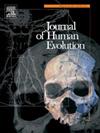半干旱草原上雄性黑猩猩饮食的营养质量
IF 3.1
1区 地球科学
Q1 ANTHROPOLOGY
引用次数: 0
摘要
营养生态学对于理解黑猩猩(类人猿)的食物选择至关重要。然而,对于生活在热带草原上的黑猩猩来说,他们对食物的营养成分以及日常能量和大量营养素的摄入量还存在知识缺口。这项研究的目的是:(1)研究半干旱热带草原上的成年雄性黑猩猩如何选择食物;(2)比较热带草原和森林黑猩猩的食物。我们进行全天焦点跟踪,观察食品加工行为(87天),综合测量每日食物摄入量(25天)。我们采集了49种植物和4种昆虫,估算了它们的能量和常量营养素含量。食物消耗与其盈利能力(每小时热量产量)呈正相关,但与食物丰富度或分配无关。猴面包树生长季节的日代谢能和水溶性糖的摄入量高于非猴面包树生长季节,社会地位提高了糖的摄入量,这表明丰戈利黑猩猩对高糖食物很感兴趣。为了支持这种观点,即成熟的肉质水果的缺乏是Fongoli的环境压力,黑猩猩通常会摄入未成熟的水果和种子,其中大部分是非肉质的,可能是因为它们含有蛋白质,或者作为糖、脂肪和水的适度来源。我们的研究表明,热带稀树大草原并不是一个低蛋白质的栖息地,并表明黑猩猩——可能还有早期人类——已经适应了在热带稀树大草原环境中满足日常营养需求的方式。本文章由计算机程序翻译,如有差异,请以英文原文为准。
The nutritional quality of male chimpanzee diets in a semiarid savanna
Nutritional ecology is vital to understanding food selection in chimpanzees (Pan troglodytes). However, there are knowledge gaps for chimpanzees in savanna landscapes concerning the nutrients of their foods as well as their daily energy and macronutrient intakes. The aims of this study are to (1) examine how adult male chimpanzees in a semiarid savanna select their foods and (2) compare chimpanzee foods between the savanna and forest. We conducted full-day focal follows to observe food processing behavior (87 days) and comprehensively measure daily food intake (25 days). We sampled 49 plant and four insect species to estimate their energy and macronutrient contents. Food consumption correlated positively with its profitability (caloric yield per hour) but was not associated with food abundance or distribution. Daily intakes of metabolizable energy and of water-soluble sugars were higher in the baobab (Adansonia digitata) season than in the non-baobab season and social rank boosted sugar intakes, suggesting that high-sugar foods are prized by Fongoli chimpanzees. In support of the idea that a scarcity of ripe fleshy fruits is an environmental pressure at Fongoli, chimpanzees commonly ingested unripe fruit and seeds, mostly of nonfleshy types, potentially for their protein content or as moderate sources of sugar, fat, and water. Our study indicates that the savanna is not a low-protein habitat and suggests ways that chimpanzees—and potentially early hominins—have adapted to meet daily nutritional requirements in a savanna environment.
求助全文
通过发布文献求助,成功后即可免费获取论文全文。
去求助
来源期刊

Journal of Human Evolution
生物-进化生物学
CiteScore
6.30
自引率
15.60%
发文量
104
审稿时长
3 months
期刊介绍:
The Journal of Human Evolution concentrates on publishing the highest quality papers covering all aspects of human evolution. The central focus is aimed jointly at paleoanthropological work, covering human and primate fossils, and at comparative studies of living species, including both morphological and molecular evidence. These include descriptions of new discoveries, interpretative analyses of new and previously described material, and assessments of the phylogeny and paleobiology of primate species. Submissions should address issues and questions of broad interest in paleoanthropology.
 求助内容:
求助内容: 应助结果提醒方式:
应助结果提醒方式:


